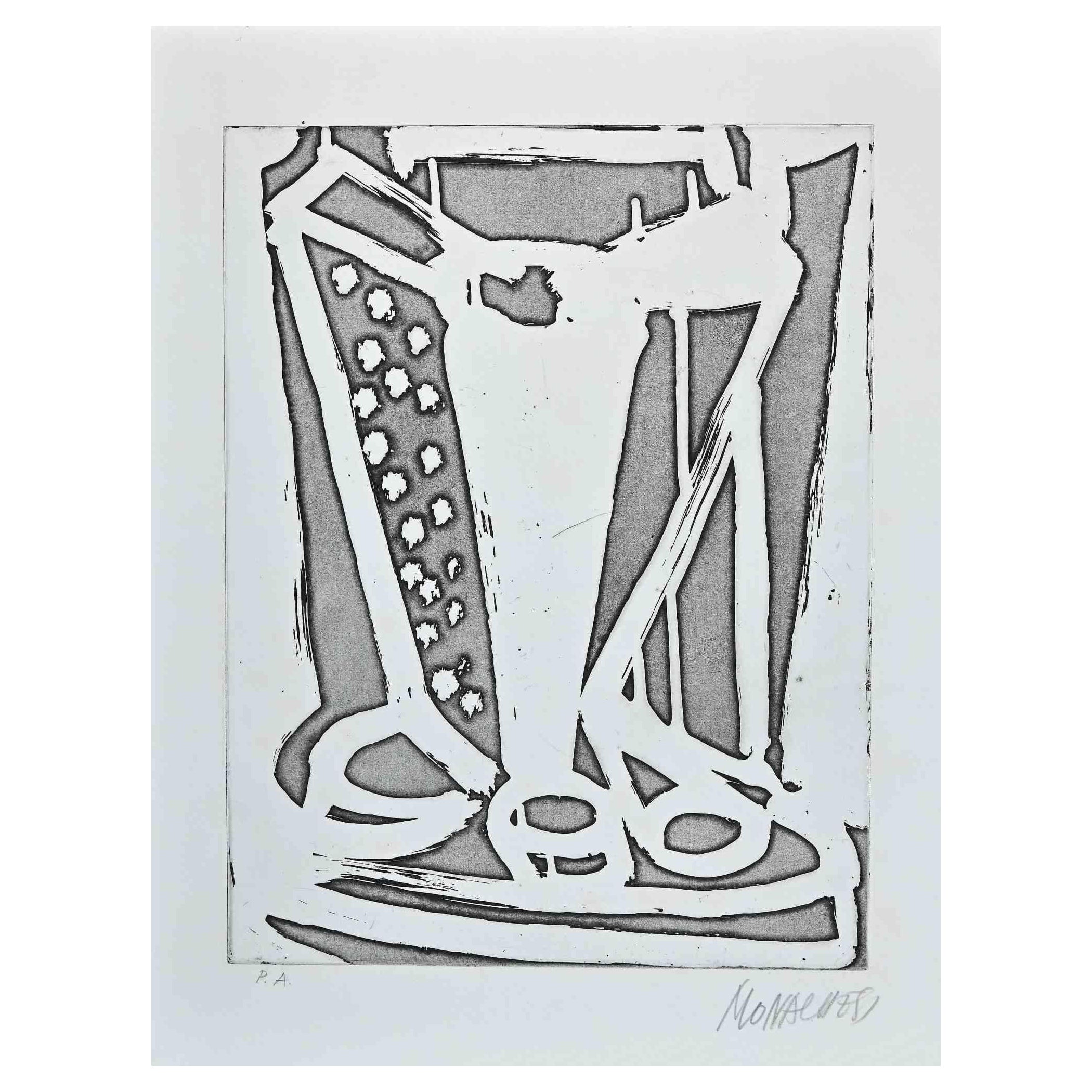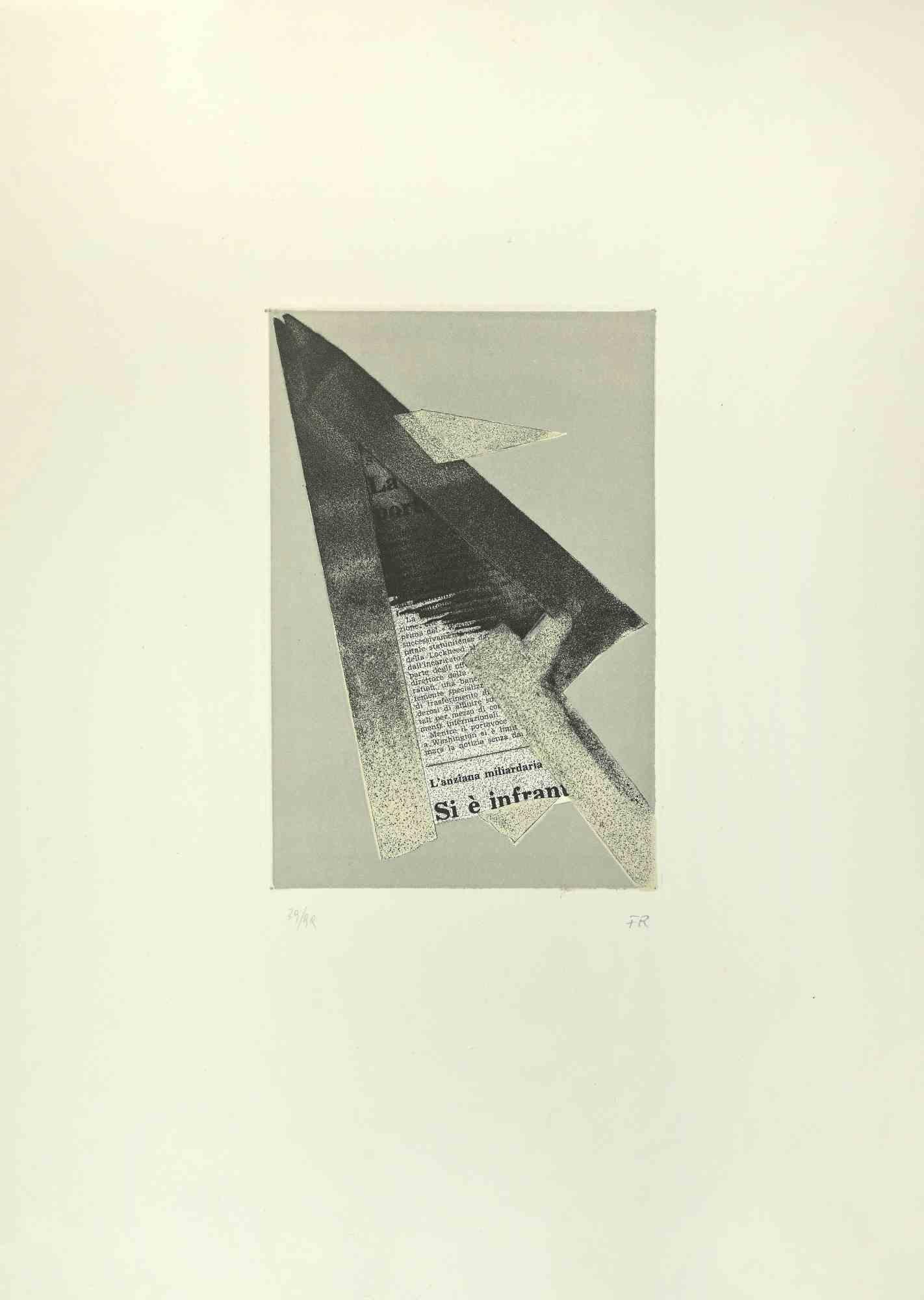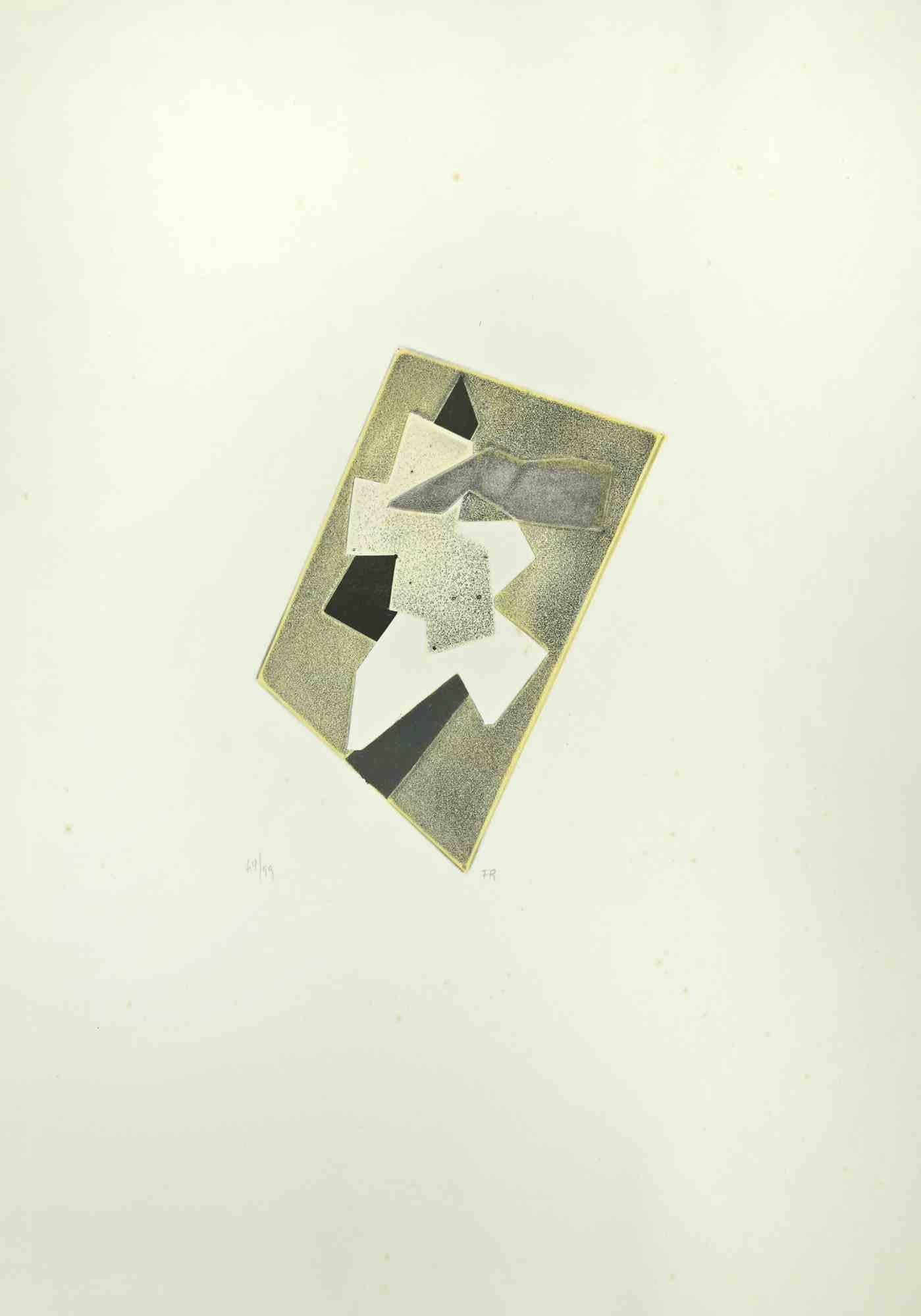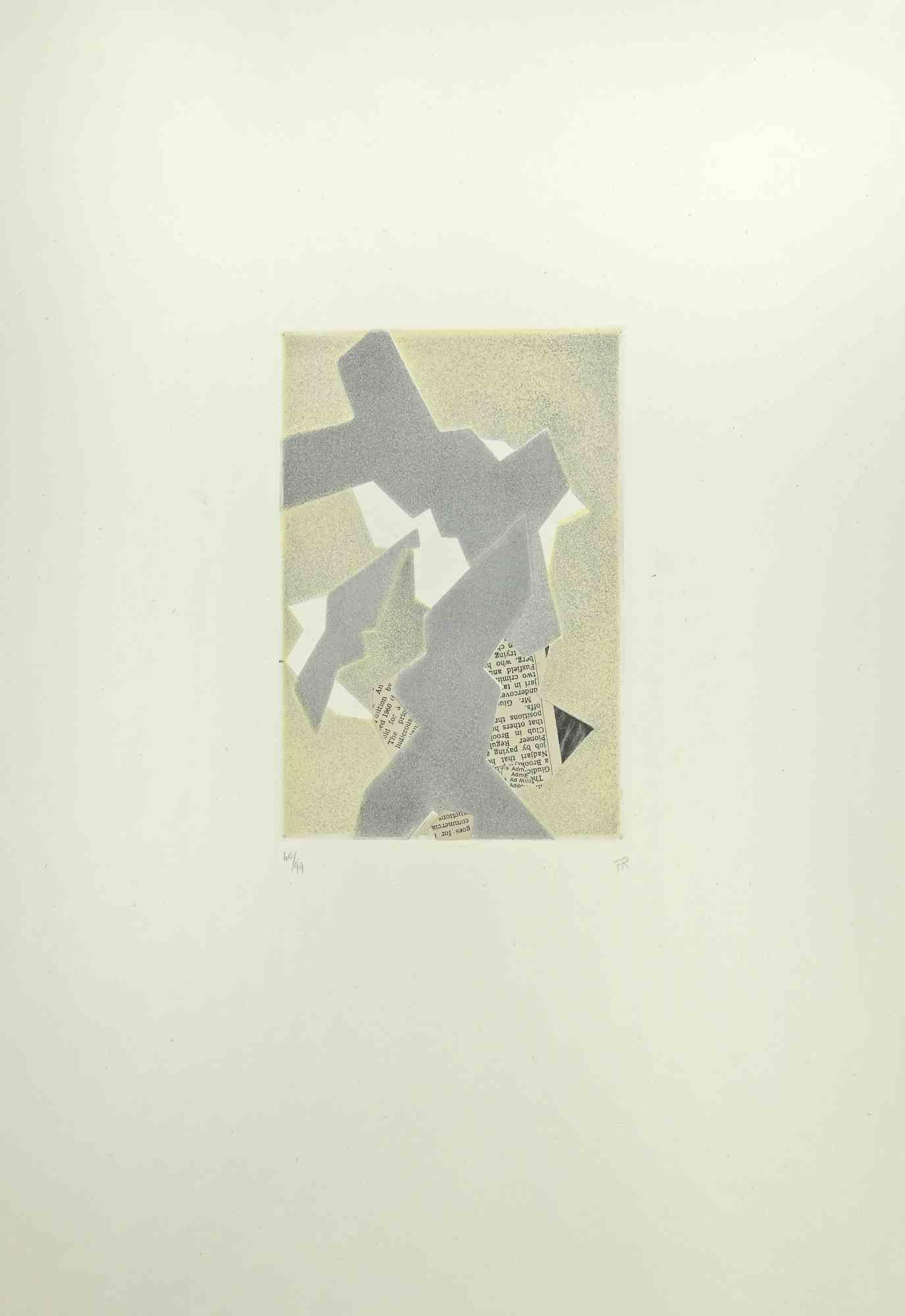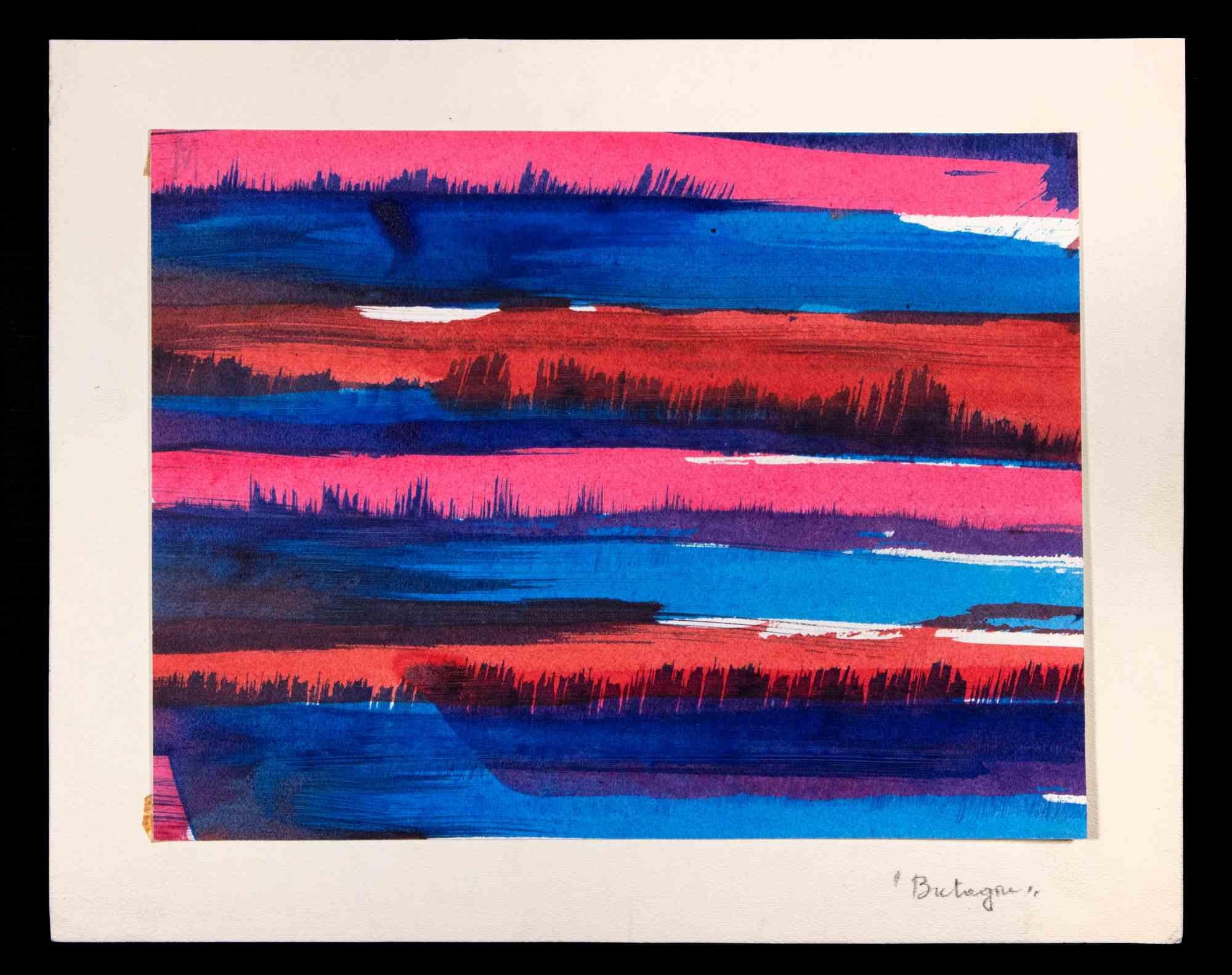Items Similar to Abstract Composition - Etching by Hans Richter - 1970s
Want more images or videos?
Request additional images or videos from the seller
1 of 5
Hans RichterAbstract Composition - Etching by Hans Richter - 1970s1970
1970
About the Item
Abstract composition is a etching and embossing realized by Hans Richter.
Monogrammed in the lower part.
50 x 35 cm. No frame.
Numbered. Edition, 48/99
- Creator:Hans Richter (1904 - 1979, German)
- Creation Year:1970
- Dimensions:Height: 19.69 in (50 cm)Width: 13.78 in (35 cm)Depth: 0.04 in (1 mm)
- Medium:
- Movement & Style:
- Period:
- Framing:Framing Options Available
- Condition:Insurance may be requested by customers as additional service, contact us for more information.
- Gallery Location:Roma, IT
- Reference Number:Seller: T-1442111stDibs: LU650313553602
Hans Richter
Hans Richter was a German painter, director, historian and theorist of experimental cinema. He is among the greatest exponents of the historical Avant-garde. Richter was one of the first artists to question the relationship between painting and cinema and to make abstract films in the early 1920s.
About the Seller
4.9
Platinum Seller
These expertly vetted sellers are 1stDibs' most experienced sellers and are rated highest by our customers.
1stDibs seller since 2017
6,757 sales on 1stDibs
Typical response time: 2 hours
- ShippingRetrieving quote...Ships From: Grasse, France
- Return PolicyA return for this item may be initiated within 14 days of delivery.
Auctions on 1stDibs
Our timed auctions are an opportunity to bid on extraordinary design. We do not charge a Buyer's Premium and shipping is facilitated by 1stDibs and/or the seller. Plus, all auction purchases are covered by our comprehensive Buyer Protection. Learn More
More From This SellerView All
- Gamma - Etching by Nicola Carrino - 1969By Nicola CarrinoLocated in Roma, ITImage dimensions: 32x32 cm. Interesting colored etching and chalcography on paper with a embossing stamp (on lower-left), representing a geometric composition. Hand-signed with penc...Category
20th Century Abstract Geometric Abstract Prints
MaterialsEtching
- Untitled - Original Etching by Margherita Benetti - 1974Located in Roma, ITHand signed and numbered by artist with pencil. Edition of 10 prints plus some artist's proof. Very good conditions.Category
1970s Abstract Abstract Prints
MaterialsEtching
- Two Figures - Etching by Luciano Minguzzi - Late 20th CenturyBy Luciano MinguzziLocated in Roma, ITImage 29.5 x 24 cm. Two Figures is an original etching on paper, realized by the Italian artist Luciano Minguzzi, the artwork is hand-signed, numbered by the artist in pencil on the...Category
1970s Abstract Abstract Prints
MaterialsEtching
- Germat - Etching by Karl Fred DahmenBy Karl Fred DahmenLocated in Roma, ITGermat is an original color etching realized by the German artist Karl Fred Dahmen in 1974. Hand-signed, titled, dated and numbered on the lower margin. Edition 94 of 100 prints. ...Category
1970s Abstract Expressionist Abstract Prints
MaterialsEtching
- Plate II from Suns/Landscapes - Etching by R. Crippa - 1971/72By Roberto CrippaLocated in Roma, ITImage dimensions: 24 x 32 cm. Plate II from Suns/Landscapes is an original artwork realized beetween 1971 and 1972 by Roberto Crippa. Mixed oclored etching. Signed on plate on the lower margin. Numbere on the lower left. Edition 23/100. The artwork is from the portfolio Sun/Landscape, edited by Graphis Arte Livorno. Colorful and power artwork with a mixed composition of geometrical shapes and with different contrasting colors. Gaetano Crippa known as Roberto Crippa (Monza, 1921 - Bresso, 1972) was an Italian painter, sculptor and aviator. He started painting in 1945, with a figurative style and cubist influence close to Picasso's style. He joined the spatial movement with Lucio Fontana, Gian Carozzi...Category
1970s Abstract Abstract Prints
MaterialsEtching
- Cosmic Garden - Etching and Drypoint by R. Castello - 1964Located in Roma, ITCosmic Garden is an original black and white etching realized by Raffaele Castello in 1964. Hand signed on the right margin. Numbered on the lower left. Edition of 102 copies (16/1...Category
1960s Abstract Abstract Prints
MaterialsDrypoint, Etching
You May Also Like
- CONRAD MARCA-RELLI Limited ed. Etching & Aquatint American Modern, ContemporaryBy Conrad Marca-Relli 1Located in Madrid, MadridConrad Marca Relli - Composition VIII Date of creation: 1977 Medium: Etching and aquatint on Gvarro paper Edition: 75 + AP + HC Size: 56 x 76 cm Condition: In very good conditions an...Category
1970s Abstract Abstract Prints
MaterialsPaper, Etching, Aquatint
- Composition #4By Renaud AllirandLocated in Palm Springs, CAMonotype completed during his period as Resident Artist at the French Institute of Tangier. Signed on the reverse. RENAUD ALLIRAND was born in 1970, and currently lives and works in...Category
2010s Abstract Abstract Prints
MaterialsEtching, Monoprint
- Stanley Boxer Aquatint Intaglio Etching Elephant Herd Abstract ExpressionistBy Stanley BoxerLocated in Surfside, FLElephants. 1979 edition 2/20 Hand signed and dated Framed 24.5 X 28. Sheet 23 X 26 This is from a series of prints Boxer produced at Tyler Graphics between 1975 and 1979. Over this period, he created several series of intricately rendered figurative works, illustrating whimsical scenes featuring animals, plants and nubile winged figures. Boxer had, however, been making drawings of this nature throughout his career, and he insisted they were closely connected to his abstracts, made with similar gestures and motivation. The Tate Museum received twenty-five of Stanley Boxer’s prints as a gift of Kenneth Tyler from Tyler Graphics, comprising a complete portfolio of Ring of Dust in Bloom, 1976, an incomplete portfolio of Carnival of Animals, 1979, and two individual prints. This work is from Carnival of Animals, a portfolio of fourteen intaglio prints on handmade paper. Tate holds eleven of the prints from this portfolio (Elephants, Swan and Fossils are not in Tate’s collection). Stanley Boxer (1926-May 8, 2000) was an American abstract expressionist artist best known for thickly painted abstract works of art. He was also an accomplished sculptor and printmaker. He received awards from the Guggenheim Fellowship and the National Endowment for the Arts. Boxer was born in New York City, and began his formal education after World War II, when he left the Navy and studied at the Art Students League of New York. He drew, painted, made prints, and sculpted. His work was recognized by art critic Clement Greenberg, who categorized him as a color field painter, A group that included Barnett Newman, Clyfford Still, and Mark Rothko and was a form of Abstract Expressionism and later included Helen Frankenthaler, Ad Reinhardt, Kenneth Noland, Gene Davis, Jules Olitski, Raymond Parker and Morris Louis. Boxer himself was adamant in rejecting this stylistic label. Over the years, he remained loyal to the materially dense abstract mode on which his reputation rested.. Art critic Grace Glueck wrote "Never part of a movement or trend, though obviously steeped in the language of Modernism, the abstract painter Stanley Boxer was a superb manipulator of surfaces, intensely bonding texture and color." In 1953 Boxer had his first solo exhibition of paintings in New York City, and showed regularly thereafter until his death. His paintings and sculpture were represented in New York City during the late 1960s through 1974 by the Tibor de Nagy Gallery, then by the André Emmerich Gallery from 1975 until 1993, and finally by Salander-O'Reilly Galleries until its demise in 2007. Richard Waller, director of the University of Richmond's Harnett Museum of Art, describes his evolution as an artist: You can see the shift from working with figurative imagery in the 1940s and early '50s to abstraction in the late '50s. The abstraction in the late '60s and '70s was more derived from color-field issues. In the 1980s, Boxer really hit his stride in larger works with lots of thick paint and splashes of color. He sold a lot, and his success in the art world in the 1980s gave him the freedom to do what he wanted to do most. He was married to painter and artist Joyce Weinstein. The Boca Raton Museum of Art in Florida hosted an exhibition entitled Expanding Boundaries: Lyrical Abstraction Selections from the Permanent Collection. At the time the museum issued a statement that said in part: "Lyrical Abstraction arose in the 1960s and 70s, following the challenge of Minimalism and Conceptual art. Many artists began moving away from geometric, hard-edge, and minimal styles, toward more lyrical, sensuous, romantic abstractions worked in a loose gestural style. These "lyrical abstractionists" sought to expand the boundaries of abstract painting, and to revive and reinvigorate a painterly 'tradition' in American art. "Characterized by intuitive and loose paint handling, spontaneous expression, illusionist space, acrylic staining, process, occasional imagery, and other painterly techniques, the abstract works included in this exhibition sing with rich fluid color and quiet energy. Works by the following artists associated with Lyrical Abstraction will be included: Natvar Bhavsar, Stanley Boxer, Lamar Briggs, Dan Christensen, David Diao, Friedel Dzubas, Sam Francis, Dorothy Gillespie, Cleve Gray, Paul Jenkins, Ronnie Landfield, Pat Lipsky, Joan Mitchell, Robert Natkin, Jules Olitski, Larry Poons, Garry Rich, John...Category
1970s Abstract Expressionist Animal Prints
MaterialsEtching, Aquatint, Intaglio
- Venetian Views: Venice, Afternoon -- Print, Hand-coloured by Howard HodgkinBy Howard HodgkinLocated in London, GBVenetian Views: Venice, Afternoon, 1995 Howard Hodgkin Lift-ground etching and aquatint with carborundum printed in colours with hand-colouring in cadmium yellow, mars yellow and ph...Category
1990s Abstract Abstract Prints
MaterialsAcrylic, Etching, Aquatint
- Michael David, Mugual Indian Star Abstract Expressionist Color Etching PrintBy Michael DavidLocated in Surfside, FLMichael David (b. 1954) Hand signed, Prestige Art blind stamp; edition of 45; 1993 Color Etching on Arches Buff "The Mugual Series" Printed by the artist with master printers Sylvia Roth and Mary Seibert at Hudson River Editions and published by Prestige Art Ltd., Mamaroneck, New York. 22 X 18 framed Michael David Singer; born 1954, is an American painter. Born in Reno, Nevada, David's family relocated to Brooklyn, New York, where he was raised. He attended SUNY Fredonia for one year and in 1976 received a B.F.A. from Parson's School of Design. Michael David is classified as an abstract painter, best known for his use of the encaustic technique, which incorporates pigment with heated beeswax. He is also known for his works in mixed-media figure painting, photography and environmental sculpture. His work is included in the permanent public collections of the Metropolitan Museum of Art, the Guggenheim Museum, the Jewish Museum in New York, the Museum of Contemporary Art in Los Angeles, and the Los Angeles County Museum of Art, among others. In 1976 David, erotic photographer Roy Stuart and Fredonia friend Richie Stotts formed a band called The Numbers, with David on bass. The group was a fixture in New York's early punk rock music scene, playing in clubs alongside punk pioneers Television, Blondie and the Ramones. David also played bass with punk innovators Jerry Nolan of The New York Dolls, Cheetah Chrome of The Dead Boys, Marky Ramone, Peter Gordon, David Van Tieghem and the free-improvisation noise music group Borbetomagus. In 1977, The Numbers were approached by impresario Rod Swenson, who was seeking musicians to form a backing band for singer Wendy O. Williams, whose radical persona he sought to exploit as punk music and performance art. The Numbers became The Plasmatics but the attention David began to gain as an important voice in the art world caused him to leave the band to pursue his burgeoning painting career. David's first one-man show was in 1981 at the historic Sidney Janis Gallery. That year he was awarded a Guggenheim Fellowship, at the time the youngest artist ever to do so, and in 1982 was awarded an American Academy of Arts and Letters prize. He went on to exhibit at galleries worldwide and was represented by Knoedler & Co. for the next 25 years. David is best known for using the encaustic technique of painting, which uses pigment combined with heated beeswax. David built his early career on abstraction and religious iconography, which formed the bulk of his output until 1999. Since then he has also experimented with representational painting and traditional photography. In 2000, he developed the "Chortens" and "Populations" series, about which prominent art historian and critic Donald Kuspit writes: "They are enigmatic works, all the more so because of the way their innumerable details form singularly monumental, intimidating wholes. Dense yet delicate, awesome yet intimate, they convey the fragility as well as grandeur of sheer being. Layer upon layer of paint piles up like layer upon layer of coral, but the textural result is more epic, not to say startling, than any coral island, and virtually any other existing abstract expressionist painting (upon which they are stylistically founded)." In 2001, David developed bi-lateral neuropathy due to being poisoned by gases released by overheated beeswax used in the encaustic process. The disease left him with partial paralysis of his legs, slowing the production of his painting for a number of years. That year, David began painting one of his best-known series, the "fallen Toreadors", inspired by 19th century French Realist painter Édouard Manet's "The Dead Toreador" of 1864. In 1993, David experimented at the "20x24" Polaroid studio in Manhattan, which resulted in a series of portraits of playwright Edward Albee and of friend Jackie Gross, which would become the ongoing "Jackie" series of mixed-media works. When neuropathy rendered him unable to paint during 2003, he returned to the 20x24 camera and shot large-format Polaroids inspired by Caravaggio; nude men and women dressed as Toreadors, and religious imagery. In 2002, David began to develop The Greenhouse Project, an evolving "architectural construct" based on historical American Antebellum greenhouses built using the actual glass negatives sold to starving farmers in the post-American Civil War South. David has indicated that each greenhouse will, through the display of photography and use of social networking, create a forum and exhibit for ideas and artifacts related to civil and human rights; the specifications of each greenhouse particular to the community in which each is built. David's work was reviewed in Artforum and Art in America, and is considered one of the last links to the New York School of painting. David may be the most innovative master of immediate surface since the abstract expressionists. He has acknowledged his debt to Abstract Expressionism, but he has transformed it. Where the abstract expressionist paintings of the forties and fifties seem like modern cave paintings, as their crude, unfocused, often meandering, turbulent painterliness suggests, and as such to reinstate prehistory, David seems to turn the cave into a temple, as his more considered, concentrated, indeed, dense, contemplative painterliness indicates, so that his paintings have the aura of post history. SELECT GROUP EXHIBITIONS 2010-2011 “Post Mammalian Tension, Michael David & Scott Browning”, Bill Lowe Gallery, Atlanta, GA 2006 “Unspoken Connections,” The Lowe Gallery, Santa Monica, CA 2004 The Lowe Gallery, Atlanta, GA 1999 “Waxing Poetic: Encaustic Art in America,” Montclair Art Museum, Montclair, NJ “Forty Years of American Drawings,” Raab Galerie, Berlin, Germany 1997 “Michael David and James Hyde,” Margulies Taplin Gallery, Coral Gables, FL 1996 “Different Sides: Drawings/Photographs/Prints/Paintings/Sculpture,” Knoedler and Company, New York, NY 1994 “Michael David: Paintings / Nicholas Pearson: Sculpture,” Margulies Taplin Gallery, Boca Raton, FL 1991 “Working with Wax: Ten Contemporary Artists,” Tibor de Nagy Gallery, New York, NY 1989 “Projects and Portfolios: the 25th Print National,” The Brooklyn Museum, Brooklyn, NY “Important Works on Paper,” Meredith Long and Company, Houston, TX “New Editions,” Pace Prints, New York, NY 1988 “Golem! Danger, Deliverance, and Art,” The Jewish Museum, New York, NY 1987 “Monotypes,” Pace Editions, New York, NY “Working in Brooklyn / Painting,” The Brooklyn Museum, Brooklyn, NY “Art Against AIDS,” benefit exhibition Knoedler and Company, New York, NY “Jewish Themes: Contemporary American Artists,” Spertus, Chicago, IL 1986 “First Impressions: Recent Monotypes by 15 Artists,” Allan Frumkin Gallery, (Charles Arnoldi, Pat Steir etc) “Saints and Sinners: Contemporary Responses to Religion,” De Cordova Museum, Lincoln, MA “Jewish Themes: Contemporary American Artists,” The Jewish Museum, New York, NY “Public and Private American Prints Today,” Brooklyn Museum, Brooklyn, NY 1985 “A Decade of Visual Arts at Princeton: 1975-1985,” The Art Museum, Princeton University, Princeton, NJ 1984 “Cunningham Dance Benefit,” Leo Castelli Gallery, New York, NY (Robert Rauschenberg, Arman etc) Twelve Abstract Painters, Siegel Contemporary (Elizabeth Murray, Melissa Meyer, Leon Polk Smith etc.) “Small Paintings,” Jeffrey Hoffeld Gallery, New York, NY 1982 “Elaine de Kooning’s Inadvertent Collection,” Elaine Benson Gallery, Bridgehampton, NY 1981 “New Visions,” The Aldrich Museum of Contemporary Art (James Biederman, Louisa Chase,Mel Kendrick etc.) 1980 “Seven Young Americans,” Sidney Janis Gallery, New York, NY (Sean Scully, Thornton Willis...Category
1990s Abstract Expressionist Abstract Prints
MaterialsEtching
- Evergreen Lane (Abstract print)By Melissa MeyerLocated in London, GBEvergreen Lane (Abstract print) Etching - Unframed. This print is last in edition. This etching refers to a Steamboat Springs, Colorado street. It...Category
Early 2000s Abstract Expressionist Abstract Prints
MaterialsEtching
